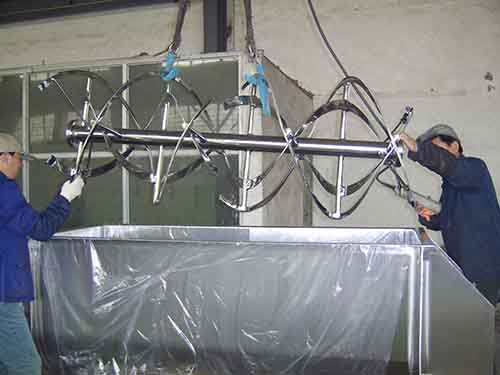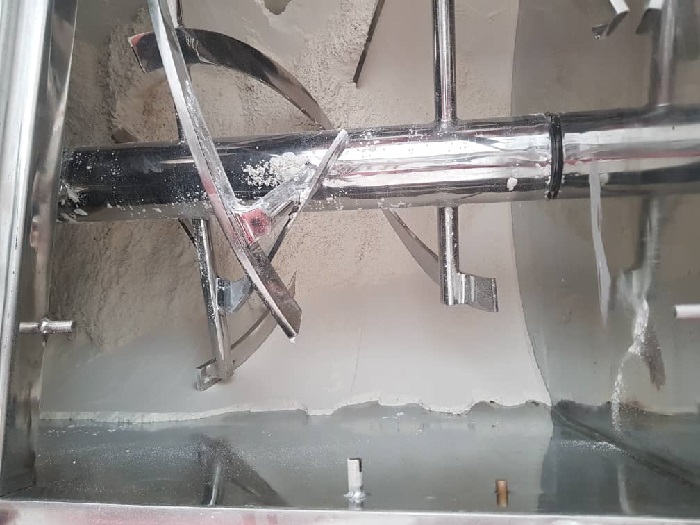This article aims to provide a better understanding of the operating principles, important features, and limitations of ribbon blenders while also highlighting some basic best practices for efficient processing in a ribbon blender.

A ribbon blender can be part of the manufacturing process for foods, pharmaceuticals, cosmetics, chemicals, plastics, agricultural products, and other bulk solids. Given this blender type’s versatility and economy, the classic blender is often a good choice for blending applications without complex temperature/pressure requirements and with no chemical reactions or other complicating factors. That said, ribbon blenders may be engineered to accommodate demanding applications.
A typical ribbon blender consists of a U-shaped horizontal trough and an agitator made up of inner and outer helical ribbons that are pitched to move material axially, in opposing directions and radially. Blending cycles are relatively fast, and mix quality is easy to duplicate from batch to batch. In principle, a ribbon blender requires very little maintenance, even when subjected to frequent material changeovers. Scaling up from a pilot-scale ribbon blender operation to large-volume production is also generally uncomplicated. To ensure a quality mixing performance for your application, it’s important to begin with proper blender sizing, specification, and customization. This article will outline some strategies for achieving efficient blending with a ribbon blender and ensuring a long service life.
It’s important to begin with detailed information on the material being mixed(bulk density, shear sensitivity, flow characteristics), and you should have detailed discussions with a trusted manufacturer – ideally accompanied by blender testing and simulation trials, when possible. These steps combined with the following information will help you determine the best mixing strategy for your particular requirements.
Blender selection and specification
Some of the most crucial ribbon-blending best practices take place even before the blender is installed. When procuring a new blender, it’s important to keep in mind the sizing parameters as well as features that can be modified to better handle your particular application. Off-the-shelf models are available at basic prices and can help manufacturers with very urgent needs, but customizing the multipurpose ribbon blender to meet your own process requirements doesn’t necessarily add significant capital cost or lead time. The key is to define your objectives in detail so you can confidently select a ribbon blender that is neither under-specified nor over-engineered.
The desired batch volume determines the blender size, but material bulk density identifies the appropriate blender class: standard or heavy-duty. Industry-wide, most standard ribbon blenders can handle bulk densities of around 0.5-0.6kg/L. Denser materials will require a more robust blender. If you intend to produce different recipes in a single blender, factor in the lowest and highest material bulk densities to come up with the correct blender capacity and motor size.
The blender’s drive arrangement is another major factor that varies from supplier to supplier. To date, the most reliable drive design is the one-piece motor reducer, also called a gearmotor. This direct drive arrangement is more efficient and compact compared to a belt drive, which relies on flexible belts and aa set of pulleys to help produce the desired speed and torque ranges. Belt-driven and chain-driven ribbon blenders tend to suffer from horsepower and efficiency losses through slippage. Belts and chains also impose over-hung loads, which are forces exerted perpendicularly to a shaft that overload the equipment and can limit the longevity of the motor and reducer bearings. Belt-driven and chain-driven blenders have limited flexibility and typically can’t accommodate frequent start-stop blending cycles.
By comparison, modern gearmotors deliver higher operating efficiency and better performance along with several practical advantages when compared to the aforementioned belt-driven and chain-driven blenders. Because overhung loads on the motor and reducer-shaft bearings are eliminated in gearmotors, service life is longer. Maintenance to align and adjust belts and couplings is eliminated, as well. A modern compact gearmotor allows for smaller mounting platforms on the blender, which reduces the ribbon blender’ overall space requirement. Just as important, gearmotors are designed to work well with a variable-frequency drive(VFD), which provides enhanced speed control, over-load protection, and adjustable starting torques.
Common ribbon blender processes
Ribbon blenders can be customized to fit various applications across a wide range of industries. Let’s define some common processes and briefly discuss how the ribbon blender can be used for each.
Powder blending. Batching dry ingredients is perhaps the most common ribbon blender operation. Examples include baking mixes, tablet formulations, powdered flavorings, protein supplements, chemical additives, and many more. A typical mixing cycle takes no longer than 15 minutes, and with the ribbon agitator continuing to run, the discharge step is also completed quickly as the turning ribbon helps accelerate the discharge rate. Powder blending is a straightforward process that a basic ribbon blender can easily handle provided it’s sized for the right material bulk density for the application at hand.
Depending on the material characteristics of the powders in your batch’s recipe, some optional ribbon blender features are worth considering. For example, to reduce dusting, opt for a dust-tight discharge valve and clamps to secure the blender’s gasketed cover. When handling fine or abrasive powders, install lantern rings to provide air purging of the packing gland. Maintaining a slightly positive pressure of air during blending will prevent particles from penetrating the stuffing box and protect the shaft from wear.
Coating particles with a minor ingredient. Another use for the ribbon blender is coating solid particles with a minor ingredient that is typically significantly smaller in particle size(for instance, coating polyethylene beads with a fine powder lubricant) or a liquid ingredient, such as when spraying flavoring oil onto roasted coffee beans. In these processes, the presence of a minor or trace ingredient necessitates more accurate mixing. Close tolerance – in the range of 3-5mm – between the outer ribbon and the U-shaped trough become very useful in eliminating dead zones within the blender where material can stagnate. The interior stainless steel surfaces must be well polished, and each weld should be given a rounded or curved edge, i.e. radiused. Adding scrapers to the ends of the ribbon agitator further minimizes material buildup along the end walls of the vessel. The method and rate at which each minor component is added to the mixture also affects mixing efficiency and must be considered during blender selection.
Mixing solids of different particle shapes and sizes. In this scenario, the different components in a mixture vary in shape, size, and density. One such example of this application is trail mix, a snack typically consisting of nuts, dried fruit, seeds, chocolate pieces, pretzels, granola, and other ingredients. Achieving a thorough blend must often be balanced with minimizing damage to the more delicate ingredients. Fast and gentle mixing in a ribbon blender is a suitable method for preparing this type of blend. With one or more sensitive ingredients, however, a paddle-style agitator may be recommended instead of the double-ribbon design, which inherently generates pinch points near the vessel walls wherein relatively large and delicate particles may be compressed, leading to breakage or material deformation. Testing is recommended to confirm the appropriate mixer speed, cycle time, and agitator design for a particular blend.
Vacuum drying. Agitated vacuum drying is another process performed by a horizontal blender equipped with a ribbon agitator, paddle blades, or a combination of both mixing tools. This process requires a customized blender with a heavy-duty cover, clamps, a vacuum-tight valve, and more. Talk to your supplier for a full list of required customizations. Vacuum drying is an efficient method for removing volatile components from pharmaceutical granulations, chemicals, plastics, ceramics, metals, and other materials. The combination of reduced pressure and constant agitation accelerates drying even at low temperatures. The low-temperature drying process that can be achieved with a vacuum-rated blender is ideal for heat-sensitive materials prone to thermal degradation when exposed to high temperatures. The operation also facilitates complete recovery of costly solvents and safe disposal of any harmful materials removed from the totally enclosed blender.
Additional ribbon-blender tips
Here are some general tips to consider when selecting a ribbon blender.
Choose a level installation location. A ribbon blender is normally supplied in a floor-mounted design. This design requires the blender be bolted to a level floor made from a strong, suitable material, such as heavy-duty concrete, that can handle the weight of the equipment and material. A ribbon blender can also be installed on a stable mezzanine. Bolting the ribbon blender to an unlevel surface may deform the mixing trough and cause clearance issues between the trough and ribbon agitators.

Select a correctly sized blender. Batch volume (not mass) dictates the size of the ribbon blender you’ll need, and the bulk density of your component materials determines the correct horsepower. Most standard-duty agitator shafts and spokes are recommended for materials with bulk densities of up to 0.6kg/L only. Heavy-duty blenders are typically required for denser materials. Running an overweight batch on a light-duty ribbon blender, even when the material lever(volume) is below maximum, could overload the motor or lead to a more serious mechanical failure.
Fill your blender properly. Optimal mixing in a ribbon blender requires that the batch size, the material volume in the vessel, be equivalent to at least 30 to 40 percent of the blender’s rated volumetric capacity. Recommended turndown ratio will be confirmed by the blender supplier. Working with smaller volumes may cause the blender to fail to generate adequate contact between the agitator and the material.
Communicate with your supplier. Discuss your process and requirements with our supplier to ensure the ribbon blender is designed appropriately. For example, in some rare cases, you may want to remove the agitator shaft when cleaning. Some companies prefer to do so to eliminate cross-contamination of highly sensitive batches. To ensure proper agitator alignment, simple customizations can be made, including match marks on the shaft flanges to align the agitator shaft during reinsertion. More elaborate equipment modifications allow operators to quickly raise the agitator out of the blender without moving the end shafts, bearings, or seals.
Use a variable-frequency drive. Using a variable-frequency drive(VFD) with your ribbon blender allows for a slow motor start under a full batch load, protecting the system against a spike in startup torque. Electronic soft starters work just as well to reduce the system load, but a starter allows only single-speed operation during blending.
Fine-tune shear input. When mixing various materials on a single machine, you can take advantage of the ribbon blender’s versatility by using a interchangeable paddle agitator (to handle fragile ingredients) or high-speed blades (to disperse lumps). Chopper blades can be installed through the side of the vessel or mounted on the top cover.



